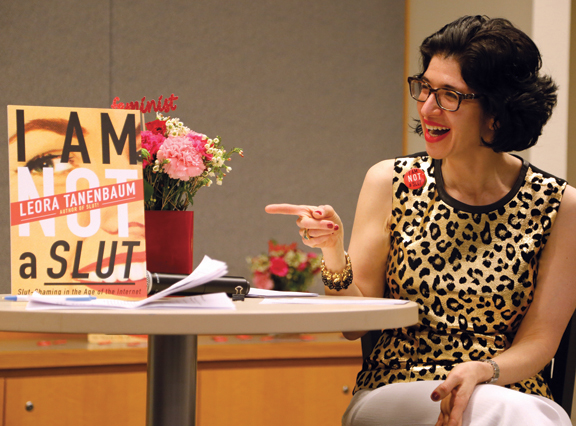I Am Not a Slut: Slut-Shaming in the Age of the Internet by Leora Tanenbaum ’91 (Harper Perennial)

Sexting. Hooking up. Posting provocative pictures on Facebook. If you’re old enough to remember when the Internet became a thing, then chances are you shake your head in wonder and judgment at what these kids—particularly young girls—are up to online.
With I Am Not a Slut, Leora Tanenbaum ’91 wants you to know that, given the toxic atmosphere many girls face, these seemingly self-destructive behaviors are understandable. “When femininity is equated with sexuality . . . ,” she writes, “then looking and acting ‘hot’ while protesting that looking and acting ‘hot’ wasn’t really their intention is rational behavior.”
A senior writer for Planned Parenthood, Tanenbaum authored the seminal 1999 SLUT! Growing Up Female with a Bad Reputation, and with this book she returns to the sexual double standard that allows men to be sexually free—even predatory—without censure but dictates strict rules for women. A woman must act sexually confident but not needy; she must not be a prude but not be too experienced either; and, above all, she must exude “effortless perfection.” To violate these unspoken rules puts one at risk of being labeled a slut—in a bad way.
In some ways, this is an age-old story. But several changes, even in the last fifteen years, have refined how the word slut sets a terrible trap for young women. For one thing, the Internet makes surveillance and judgment inescapable. Not only does social media provide a way for anyone to be “an anonymous bully with the touch of a finger,” Tanenbaum writes; it also means there’s never a time when a young woman isn’t being watched. When she is at a party, meeting a friend for lunch, or walking down the street, there’s always someone nearby with a smart phone, ready to snap a photo, upload, and tag.
What’s more, Tanenbaum is critical of the way this generation of women has embraced slut as a misguided tool of empowerment. “It’s like saying ‘hi’ in passing,” one young woman told her. But, like other derogatory words that marginalized communities have attempted to reclaim, slut is slippery. No sooner does a young woman wield the word as a way to wrest power than the word gets turned against her.
I Am Not a Slut is an easily readable (if deeply disturbing) book. Tanenbaum interviewed fifty young women whose personal stories are front and center here, alongside Tanenbaum’s broader cultural research. The book also includes such practical advice as “Do’s and Don’ts for Parents of Teenagers and College-Age Children” and “The Slut-Shaming Self-Defense Toolkit.”
Fifty young women is a rich but not statistically significant sample, and at times it’s hard to know how safe it is to extrapolate from these limited experiences. Still, it’s undeniable that women are daily bombarded with contradictory and dehumanizing messages about their bodies and their sexuality, and, further, that many young people respond to these cultural toxins in ways that are not entirely healthy. Tanenbaum adeptly lays bare how and why this is so, and she admonishes us all to respond with love and compassion.
“Remember, you are not a slut,” she writes. “And neither is anyone else.”





